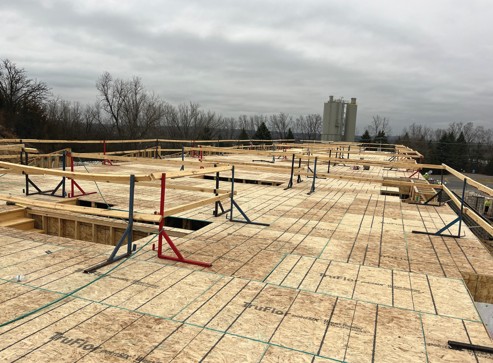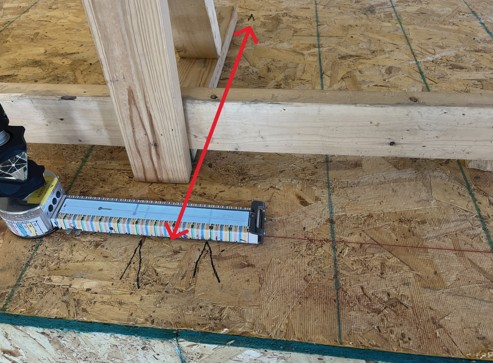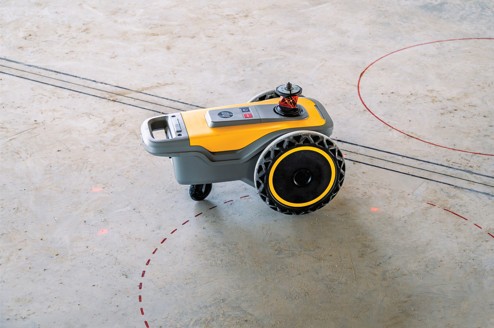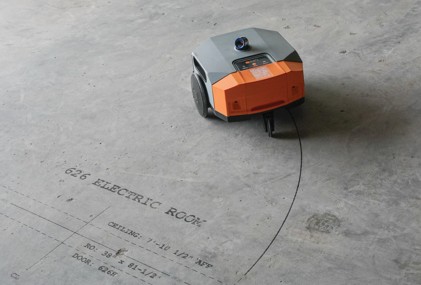Laying It Out in the Field
Exploring New Robotic Tools for Onsite Efficiency
by Christine Wagner
Framers today face no shortage of challenges. Between tighter build schedules, an aging workforce, and a shrinking pool of skilled labor, the pressure is on to keep projects moving, and without sacrificing quality. At the same time, the complexity of projects is increasing, and so is the demand for more efficient, digitally integrated construction practices.

Layout is just one area in which efficiency can be improved. It sets the course for framing crews, trade coordination, and overall jobsite flow. By automating this early step, robotic systems help framers move faster, make fewer errors, and reduce the daily friction that can slow down production.
Field robotics is emerging as a smart solution. These systems automate layout by transferring digital models directly to the jobsite floor, speeding up the process, improving accuracy, and reducing reliance on highly skilled labor for repetitive and time-consuming tasks. Framers using robotic layout can experience faster cycle times, smoother handoffs with other trades, and more flexibility in how they deploy their crews.
To understand some of what’s available now, Framing Today spoke with three companies offering robotic layout systems for framers: Botmark, HP SitePrint, and Dusty Robotics. While each system is different, they all offer framers powerful tools to address some of today’s toughest jobsite challenges.
Botmark
Born from the needs of a framing contractor with lessening experience in its labor force, Botmark was developed. Layout was consuming the time of experienced field crews, making it harder to manage projects effectively. “As the managers for our framing company, my son and I became trapped performing every layout over managing productivity,” says Dean Onchuck, President of Botmark. “We realized what we had envisioned with a total station investment alone was not happening.” With their framing business now retired, the Onchucks’ focus is on helping contractors free up their skilled labor from layout.

Botmark E-Ruler. Photo courtesy of Botmark.
The Botmark system workflow combines a total station with a tablet running the Botmark app, and the proprietary Botmark E-Ruler, which includes a prism attached to it. As the user moves through the site, the base and detailing arm communicates simultaneously in real time, showing layout details right on the tool, telling the user what kind of mark to make and where to manually mark it onto the build site.
“The goal is to eliminate the need to pull out a tape measure or reference paper plans all day long,” says Arnel Onchuck, Vice President of Botmark and Operations Manager of Layout Specialties. “Our service allows quality assured detailing for layout to be done quickly, efficiently, and accurately.”
Depending on a variety of factors (i.e. job, layout, square footage, rough and uneven precast decks, railings), the time savings varies. “Every piece of detail gets marked in place with Botmark,” says Dean. “Contractors using Botmark are reporting to lay out 20,000 to 30,000 square feet in a single day, which would normally have taken the experienced crew at least two and a half days.”
That kind of turnaround doesn’t just free up skilled labor, it helps projects stay on track and schedules move forward. Botmark’s tool is designed for practical, boots-on-the-ground efficiency, with a workflow that trades time spent interpreting plans for speed and clarity.
Visit https://botmark.com/ for more information.
HP SitePrint
HP, known for its printing technology, has entered the construction space with its SitePrint robotic layout printer. Designed to work with existing total stations from various brands, HP’s system integrates with BIM and CAD workflows and uses a cloud-based platform to manage and execute layout tasks.

HP SitePrint. Photo courtesy of HP Construction Services.
The robot itself prints directly onto the slab, using durable, jobsite-tested ink. “We’re ink experts and there are a lot of crazy applications with ink,” says Andy Dickey, Head of Americas, Australia and New Zealand at HP Construction Services. “We have erasable ink, all the way up to ink that will fade in the sun to permanent ink.”
HP shares that SitePrint can, on average, complete layout up to 10 to 12 times faster than manual methods, depending on the complexity of the project and a variety of other factors, (i.e. size, square footage, type of job).
Beyond speed, SitePrint brings a high level of clarity and precision to framing and cross-trade layout. “With HP SitePrint, [framers] are getting on board with that BIM-to-field workflow, similar to how MEP trades got on board with robotic total stations,” says Alex DuVernois, Channel Manager at HP Construction Services. “It’s giving our framers another option to have a seat at the table and increase collaboration and coordination with other trades on sites to reduce those layout mismatches. We can all be working from the same set of plans, the same model, and be in coordination in every single trade.”
Whether used by framing teams alone or shared across trades, SitePrint helps speed up layout while promoting better communication and alignment across the entire jobsite.
For more information, visit https://www.hp.com/us-en/printers/site-print/layout-robot.html.
Dusty Robotics
Dusty Robotics was founded by a robotics engineer who, after remodeling her home, saw firsthand how inefficient and manual construction layout could be. Dusty Robotic’s FieldPrinter 2 is an onsite robot that connects to coordinated digital drawings and prints accurate layout lines directly onto the slab/floor, bringing speed, precision, and consistency to framing and multi-trade layout.

Dustry Robotics. FieldPrinter 2.
The company describes its platform as a “file-to-field communication system” with everyone using the same single source of truth. “You're using one robot to print and it's using all of the coordinated files from all the trades together,” says Tessa Lau, CEO and Co-Founder of Dusty Robotics. “And you're guaranteed that exactly what comes out of that coordination process is what everyone knows.”
Dusty got its start working with framing and drywall contractors, which remains a key focus. The system supports multi-trade layout and is especially well-suited for projects that involve offsite construction or prefabricated walls, where accurate placement is especially critical. Dusty is also focused on usability. Its robots are piloted with an iPad and video-game-style controller.
The result is increased layout speed and consistency. “Speed matters so much, especially to our framers,” says Tessa. “The faster we get the layout done, the faster they can come in and install it and go onto the next job.” Dusty Robotics shares that typically, its FieldPrinter 2 robot is 10-20 times faster, depending on the job, its size, and the complexity of it.
Whether used to support internal crews or generate cross-trade collaboration, its FieldPrinter 2 enables framing contractors to lead the layout process, and the jobsite.
For more information, visit https://www.dustyrobotics.com/.
Why Field Robotics Matter
Adding robotic layout to a framing operation isn’t just about adopting a new tool—it’s about creating new opportunities. Field robotics can offer a faster, more consistent way to complete layout, while reducing the strain on skilled labor and improving coordination across trades.
Josh Lewis, COO of FrameTec and SBCA member, began using robotic layout to tighten the connection between design and execution. His team already worked in BIM and manufactured wall panels offsite, so integrating field robotics into the process was a natural next step.
“The biggest objections I get from framers or from concrete guys or from other trades when they talk about problems with panelization in particular, is that if something is wrong, then the walls don’t fit,” says Josh. “In their mind, we don’t have the flexibility to adapt on the fly to changing site conditions. So I looked at the robotic layout as a way to control some of that.” Robotic layout reinforces accuracy up front, giving a reliable, precise reference point that keeps the process moving forward efficiently.
Chris Tatge, President of Dynamic Construction, sees similar value in the field. “The real benefit for us is that the guys can rely on it,” he says. “They count on it. They know the lines are good. This also helps with the alignment between my field guys and our component manufacturer. We know exactly what our crew is getting delivered to their site and where they’re being placed using robotics.”
There can be many benefits to incorporating field robotics: faster layout, fewer mistakes, and better coordination among trades are naming a few. “This model is now the basis for everything we do,” Josh explains. “It’s the basis for the robots in the plant that build the walls and it’s the basis for the robots in the field that snaps the walls; now I have two things that are synced and controlled from a single origin.”
Chris adds that the documentation these robots provide has become a game-changer. “Because I’m relying on technology instead of the guys in the field, I have all of the documentation to fall back on if something comes up on the job. It’s incredibly useful. It’s a huge benefit.”
Whether to reduce man-hours or improve precision, field robotics gives framing crews more information and new ways to stand out in the market.
The Road Ahead
Each robotic layout system takes a different approach, whether guided marking or autonomous printing, but all aim to bring greater efficiency, precision, and consistency to framing.
They’re also helping to change how framers work with other trades. “One thing that we do with one of our customers is locate all of the plumbing walls so the plumbing contractor can pre-drill and know where not to drill” says Chris. “They’ve started relying on us for this service. Having the ability to do this is a major differentiator for us with our competition.”
As experienced layout labor becomes harder to find and build schedules tighten, robotics offers a path to stay competitive. It’s not about replacing people: it’s about empowering teams to deliver higher precision with fewer headaches.
At its core, field robotics is more than automation—it’s a smart way to build better, faster, and more collaboratively.
